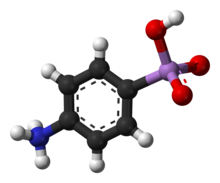Arsanilic acid

| |

| |
| Names | |
|---|---|
| Preferred IUPAC name
(4-Aminophenyl)arsonic acid | |
| Other names
4-Aminobenzenearsonic acid, 4-Aminophenylarsonic acid, 4-Arsanilic acid, Atoxyl
| |
| Identifiers | |
3D model (
JSmol ) |
|
| 1102334 | |
| ChEBI | |
| ChEMBL | |
| ChemSpider | |
| DrugBank | |
ECHA InfoCard
|
100.002.432 |
| EC Number |
|
| 406354 | |
PubChem CID
|
|
| UNII | |
CompTox Dashboard (EPA)
|
|
| |
| |
| Properties | |
| C6H8AsNO3 | |
| Molar mass | 217.054 g/mol |
| Appearance | white solid |
| Density | 1.957 g/cm3 |
| Melting point | 232 °C (450 °F; 505 K) |
| modest | |
| Hazards | |
| Occupational safety and health (OHS/OSH): | |
Main hazards
|
Toxic |
| GHS labelling: | |
 
| |
| Danger | |
| H301, H331, H410 | |
| NFPA 704 (fire diamond) | |
| Related compounds | |
Related compounds
|
phenylarsonic acid |
Except where otherwise noted, data are given for materials in their standard state (at 25 °C [77 °F], 100 kPa).
| |
Arsanilic acid, also known as aminophenyl arsenic acid or aminophenyl arsonic acid, is an
Arsanilic acid saw long use as a veterinary feed additive promoting growth and to prevent or treat dysentery in poultry and swine.[2][3][4] In 2013, its approval by US government as an animal drug was voluntarily withdrawn by its sponsors.[5] Still sometimes used in laboratories,[6] arsanilic acid's legacy is principally through its influence on Paul Ehrlich in launching the antimicrobial chemotherapy approach to treating infectious diseases of humans.[7]
Chemistry
Synthesis was first reported in 1863 by Antoine Béchamp and became the basis of the Bechamp reaction.[8][9] The process involves the reaction of aniline and arsenic acid via an electrophilic aromatic substitution reaction.
- C6H5NH2 + H3AsO4 → H2O3AsC6H4NH2 + H2O
Arsanilic acid occurs as a zwitterion, H3N+C6H4AsO3H−,[10] yet is typically represented with the non-zwitterionic formula H2NC6H4AsO3H2.
History
Roots and synthesis
Since at least 2000 BC,
In 1859, in France, while developing
Medical influence
In 1905, in Britain, H W Thomas and A Breinl reported successful treatment of
Soon, however, Robert Koch found through an Atoxyl trial in German East Africa that some 2% of patients were blinded via atrophy of the optic nerve.[14] In Germany, Paul Ehrlich inferred Béchamp's report of Atoxyl's structure incorrect, and Ehrlich with his chief organic chemist Alfred Bertheim found its correct structure[13]—aminophenyl arsenic acid[17] or aminophenyl arsonic acid[14]—which suggested possible derivatives.[14][17] Ehrlich asked Bertheim to synthesize two types of Atoxyl derivatives: arsenoxides and arsenobenzenes.[14]
Ehrlich and Bertheim's 606th arsenobenzene, synthesized in 1907, was
Contemporary usage
Arsanilic acid gained use as a feed additive for poultry and swine to promote growth and prevent or treat
Arsanilic acid is still used in the laboratory, for instance in recent modification of nanoparticles.[6]
It is a reagent for the detection of
Citations
- ^ PMID 21772505.
- ^ PMID 25101467.
- ^ ]
- ^ a b "Arsanilic acid—MIB #4". Canadian Food Inspection Agency. Sep 2006. Archived from the original on 2012-12-13. Retrieved 3 Aug 2012.
- ^ a b U.S. Food and Drug Administration (1 Oct 2013). "FDA response to citizen petition on arsenic-based animal drugs".
- ^ PMID 24246012.
- ^ Patrick J Collard, The Development of Microbiology (Cambridge, London, New York, Melbourne: Cambridge University Press, 1976), pp 53–4.
- Compt. Rend.56: 1172–1175.
- )
- .
- ^ PMID 8505753.
- ISBN 978-3-642-13184-4.
- ^ PMID 20763444.
- ^ PMID 20219092.
- ^
- Nadav Davidovitch & Zalman Greenberg, "Public health, culture, and colonial medicine: Smallpox and variolation in Palestine during the British Mandate", Public Health Reports (Washington DC 1974), 2007 May–Jun;122(3):398–406, § "Colonial medicine in context".
- Anna Crozier, Practising Colonial Medicine: The Colonial Medical Service in British East Africa (New York: I.B. Tauris & Co Ltd, 2007).
- Deborah Neill, Networks in Tropical Medicine: Internationalism, Colonialism, and the Rise of a Medical Specialty, 1890–1930 (Stanford CA: Stanford University Press, 2012).
- PMID 20771495.
- ^ PMID 18679046.
- ^ "Paul Ehrlich, the Rockefeller Institute, and the first targeted chemotherapy". Rockefeller University. Retrieved 3 Aug 2012.
- ^ U.S. Food and Drug Administration (8 Jun 2011). "Questions and answers regarding 3-nitro (roxarsone)".
- ^ U.S. Food and Drug Administration (April 1, 2015). "FDA announces pending withdrawal of approval of nitarsone". Archived from the original on 2017-04-06.

